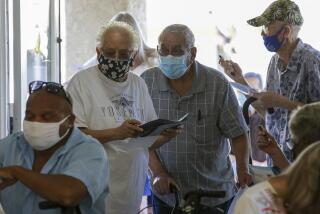Physician Group Financial Crisis
- Share via
Re “2 Dozen Doctor Groups in State Near Failure,” Sept. 2: Significant meritorious issues were raised, not the least of which is the threat to the public health and well-being should these doctor groups continue to succumb. Although there currently exists a plethora of state Senate and Assembly bills, few, if any, of the measures address the fundamental problem briefly mentioned in the article--the amount of money paid to the doctor groups from the health plans decreased by over 35% in recent years. Not mentioned is that during this same time period, the health plans have shifted pharmacy risk (the cost of medications) to the doctor groups and the cost of providing state-of-the-art patient care (diagnostic studies, laboratory screens, bioengineered products, etc.) has skyrocketed.
The solution to the solvency of the doctor groups seems obvious; the health plans need to release more funds to the doctor groups to provide quality medical care.
MICHAEL C. NELSON MD
Northridge
*
Kudos for the front-page article about the plight of physician groups in the state that are the backbone of managed health care. My only disagreement is your assertion that these physician groups unilaterally opted to assume risk to achieve medical and financial independence. The reality is that this risk was dumped on these groups by the health plans that forced them to assume risk in order to keep their patients (which begs the question of why health plans that merely act as middlemen need to exist at all).
Employers need to realize that the recent rise in health care premiums does not at all mean that insurers will increase payments to the physician groups that actually deliver the health care to their employees. Consumers who contribute to commercial, Medicare and MediCal HMOs both as patients and taxpayers need to understand that for-profit HMOs carry a 20%-25% overhead compared to nonprofit HMOs, whose overhead remains at 10%. I’m as pro-private enterprise as anyone, but when for-profit HMOs must choose daily to weigh the needs of their patients versus their investors, it’s usually the patients who lose out.
KENNETH S. ALPERN MD
Marina del Rey
More to Read
Inside the business of entertainment
The Wide Shot brings you news, analysis and insights on everything from streaming wars to production — and what it all means for the future.
You may occasionally receive promotional content from the Los Angeles Times.










